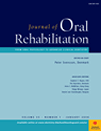Citation:
Steinberg D, Heling I, Daniel I, Ginsburg I. Antibacterial synergistic effect of chlorhexidine and hydrogen peroxide against Streptococcus sobrinus, Streptococcus faecalis and Staphylococcus aureus. Journal of Oral Rehabilitation. 1999;26 (2) :151-156.

Abstract:
Chlorhexidine (CHX) and Hydrogen peroxide (HP) are potent antibacterial agents that are used in controlling dental plaque. However, both agents bear undesired side-effects. We have tested the hypothesis that an antibacterial synergistic effect can occur between the two agents against Streptococcus sobrinus, Streptococcus faecalis and Staphylococcus aureus. We have found that at several combinations of HP and CHX an antibacterial synergistic effect does occur, while at other combinations a on-significant synergism was noticed. No antagonism between the two agents was found in our experimental system. It can be postulated that the mechanism of this synergistic effect is via alteration of the bacterial cell-surface by CHX thereby allowing for an increased amount of HP to penetrate and to react with the intercellular organelles of the bacteria. These results suggest that CHX and HP can be of use in controlling the dental plaque in the oral cavity.Publication Global ID: http://www.ncbi.nlm.nih.gov/pubmed/10080313

